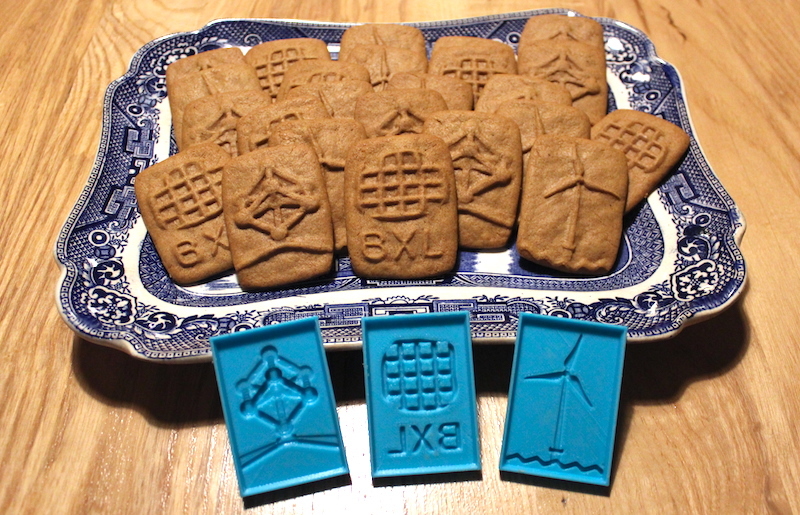
Belgian Speculoos Cookie Molds
thingiverse
Here's a fun set of speculoos cookie molds with modern designs inspired by Belgium. Enjoy! ### Safety First Naturally, there are some important considerations when using printed parts around food. In short: use food-safe filaments and coat the parts with a food-safe sealant. Also note that the molds themselves should never get hot; they’re just used to press a shape into the cool dough (read: never put the molds in the oven!). ### What is Speculoos? Anyone who’s traveled by airplane sometime in the last decade has probably been offered a Biscoff with their hot beverage: a crisp, buttery spiced cookie that’s baked to a toasted-brown color and tastes delicious alone or dunked in coffee or tea. But those in-flight snacks are just a commoditized version of the authentic artisan speculoos made in and around Belgium (Dutch “speculaas” and German “spekulatius” are quite similar, but use different sugar types and spice combinations). The genuine article is more intensely spiced and pressed by hand into wooden molds, often decorated with old-world designs. ### Belgian Shapes Having spent some time in Brussels, we grew fond of all the amazing food the city offers (craft waffles, chocolate, beer/gueuze, frites; need we say more?), as well as its gorgeous architecture, captivating museums, and unique, cartoon-laden art scene. So when it came time to decide what the molds should depict, we had no choice but to draw inspiration from our favorite Belgian landmarks. ### Making Speculoos Molds After a few iterations, we learned some things about making functional speculoos molds. Here’s a cheat sheet to help you make your own custom shapes for working with pressed dough: 1. The base cookie height should be 2-4mm (3mm seems like a practical middle ground; too thick, and the rise of the main cookie deforms the features on top). 2. The feature height should be 0.5-2.5mm (any lower and the lines disappear; any higher and dough seems to get stuck in the crevices). 3. Make sure to apply a draft angle/taper on all features to facilitate demolding of the somewhat fragile dough (10 degrees minimum). 4. Minimum feature line thickness is about 1mm (the dough is slightly grainy and has trouble reliably working in details much finer than that), so we aimed for 2-3mm grooves to allow for tapering down to 1-1.5 at the peaks. 5. Lines are visually more pronounced than steps when baked, so design accordingly (i.e. think about it like drawing line art, not solid modeling shapes in CAD). 6. Print with a layer height of 0.25mm or less. Much more than that and the slight bulge on each layer will grab the dough, making it harder to demold. We used 0.2mm layer height in the end. 7. Use straight edges for the overall cookie shape. While less decorative, this makes trimming off the inevitable squished-out dough much easier than scalloped or fluted sides. ### Technical Takeaways We've learned a thing or two about making speculoos molds along the way. Here are some key takeaways to keep in mind: * The base cookie height should be 2-4mm (3mm seems like a practical middle ground). * The feature height should be 0.5-2.5mm. * Make sure to apply a draft angle/taper on all features to facilitate demolding of the somewhat fragile dough. * Minimum feature line thickness is about 1mm. * Lines are visually more pronounced than steps when baked, so design accordingly. * Print with a layer height of 0.25mm or less. ### Baking Speculoos Once you've got your molds made, it's time to bake your speculoos! Here's how: 1. Preheat your oven to 350°F (175°C). 2. Slide your speculoos into the oven and watch them do their slow, enticing dance over 15-20 minutes. 3. For a crisper, carmelly-er speculoos, opt for a longer bake. 4. Then pull them out to cool on the baking sheet for 5 min, and transfer to a wire cooling rack for a couple hours (that’s right, 2 hours; you’re letting them dry out and crisp up here... if you’re looking for softer “cookies,” just don’t let them air out as much). 5. For those too impatient to wait for the full cooling/crisping to test them out, you’ll be glad to know that they’re also edible (scrumptious, even) warm out of the oven. ### Enjoying Your Speculoos Now that you've got your speculoos baked and cooled, it's time to enjoy! Here are some tips for getting the most out of your speculoos: * Use a wire cooling rack to let them dry out and crisp up. * For a crisper, carmelly-er speculoos, opt for a longer bake. * They're also edible (scrumptious, even) warm out of the oven. ### Conclusion We hope you've enjoyed this tutorial on making speculoos molds! With these tips and tricks, you'll be well on your way to creating delicious, authentic Belgian-style cookies that are sure to impress. Happy baking!
With this file you will be able to print Belgian Speculoos Cookie Molds with your 3D printer. Click on the button and save the file on your computer to work, edit or customize your design. You can also find more 3D designs for printers on Belgian Speculoos Cookie Molds.
